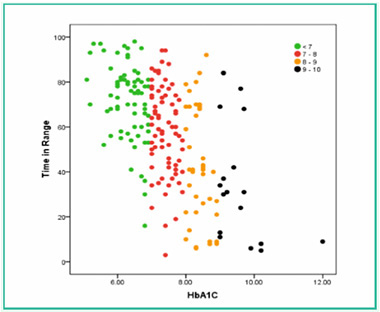
1. Outlining the relationship between Time In Target (TIT)
and Hba1c in asian indians with diabetes

This study was presented from Jothydev's Diabetes Research Centre, Trivandrum at the 13th ATTD Global Conference, Madrid, Spain. The research team headed by Dr.Jothydev Kesavadev included Dr.Arun Shankar, Gopika Krishnan, Jisha Shamsudeen and Sunitha Jothydev.
Time in Range has recently evolved as a metric to complement HbA1c and to target therapies in diabetes. Earlier studies by Dr.Vigersky et al have shown that a TIR of 70% corresponds with an A1c of 7% approximately. In this study, we have made an attempt to assess the correlation if any, from CGM obtained from our diabetes centres in Kerala, South India.
The patient cohort of 200 was divided into 4 categories; those with A1c values <7, 7 to 8, 8 to 9 and 9 to 10%. Subsequently, HbA1c values were paired against their corresponding TIT values from CGM data (Libre Pro) and reviewed to determine if any correlation existed between these metrics. Informed consent was obtained from study participants.
HbA1c was paired with TIT% (or TIR%) data and evaluated by Pearsons Coefficient ratio. Among the subjects, those with HbA1c <7% experienced stronger correlation with a signicant p value followed by patient cohort group 7-8%. Patient cohort group with HbA1c 8-9% showed a moderate correlation while the other cohort gave a weak correlation value and had a p value of no clinical significance. In elderly subset of subjects (> 60 years), in accordance with International consensus for TIR, the target value > 50% was seen as HbA1c drops below 8%.
This study from our centre in Asian Indians shows a close alignment with TIR in accordance with the International Consensus on TIR for A1c <7 and between 7-9% . However in subjects with A1c between 9-10% the correlation is weaker or not signicant implying the role of TIR as complementary and not as a replacement for A1c. In elderly, TIR becomes signicant as A1c drops below 8%.
For enquiries info@jothydev.net.
Please visit: jothydev.net | research.jothydev.com | diabscreenkerala.net | jothydev.com/newsletter
